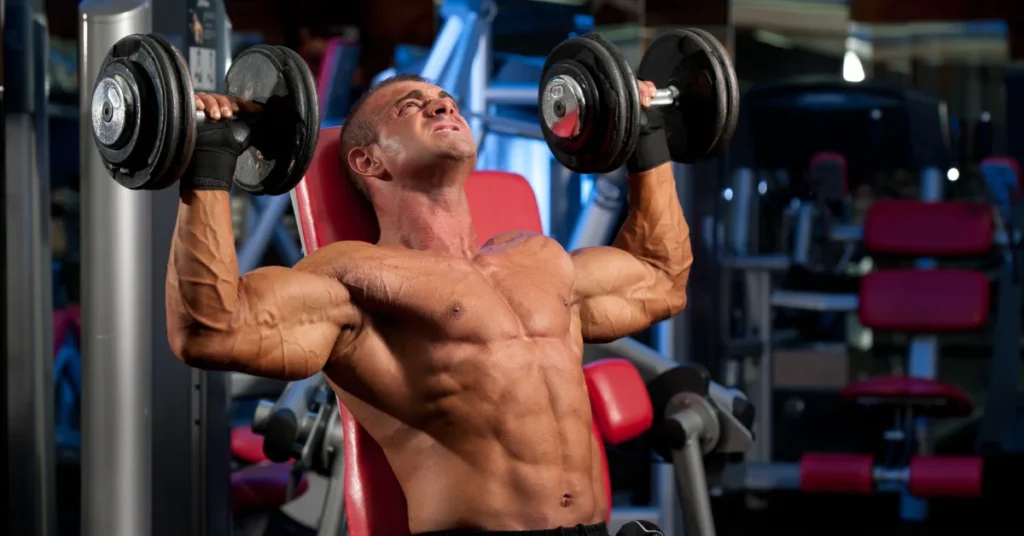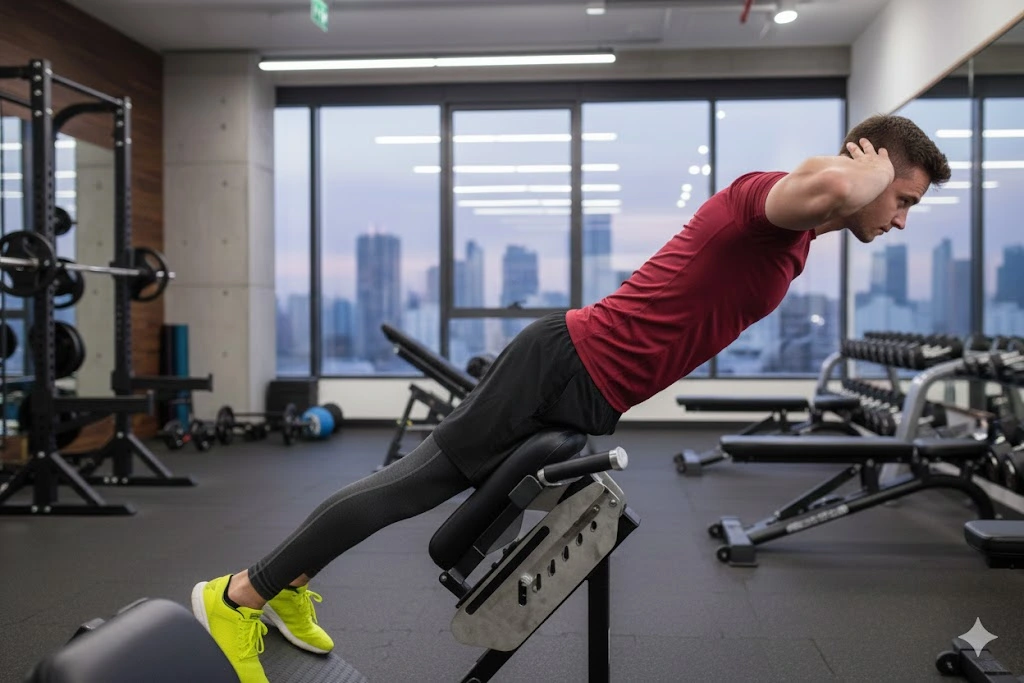Introduction
The db military press, also known as the military dumbbell press, is one of the most effective shoulder-building exercises in any workout routine. Whether you are training for strength, hypertrophy, or overall stability, this powerful movement targets key upper-body muscles with a simple set of dumbbells. It is often searched by fitness enthusiasts using terms like db military press form, seated db military press, and standing variations, and for good reason. This exercise is highly versatile, allowing for both seated and standing versions, and can be modified based on your training level.
What sets the dumbbell military press apart from other overhead presses is its ability to improve unilateral strength and correct muscle imbalances. Unlike a barbell press, using dumbbells ensures each arm works independently, activating more stabilizing muscles and building symmetry. Plus, you can perform it sitting or standing each option has unique benefits for your shoulders, core, and overall posture.
In this guide, we’ll walk you through how to do the db military press correctly, explore the muscles it works, compare the seated dumbbell overhead press with the standing shoulder press, and even provide tips to progress your lift over time. If you are wondering what muscles the military dumbbell bench works, or how to enhance your form and results, you’re in the right place.
Table of Contents
How to Do the DB Military Press (Step-by-Step)
Perfecting your military press db form is crucial not just for maximizing gains, but also for preventing injury. Whether you are aiming for a seated DB military press or the standing dumbbell press, the proper technique ensures you are targeting the right muscle groups with a full range of motion.
Step-by-Step Instructions:
- Start with the right weight: Choose a pair of dumbbells you can press for 8–12 reps with good control. Keep it lighter when learning the movement to refine your technique.
- Set your position: For the seated dumbbell overhead press, use a bench with back support. Sit upright with feet flat on the floor. If you’re doing the standing overhead press, stand tall with feet shoulder-width apart and core braced.
- Grip and starting position: Hold a dumbbell in each hand at shoulder height with palms facing forward. Elbows should be slightly in front of the body, not flared out. Wrists stay straight and stacked directly over the elbows.
- Press upward: Inhale, then exhale as you press both dumbbells overhead in a controlled arc not straight up. Lock your arms out at the top without overextending your back.
- Lower with control: Bring the dumbbells down slowly to the starting position, keeping tension in your shoulders throughout.
- Repeat: Perform 8–12 reps per set depending on your goal, resting 60–90 seconds between sets.
Pro Tip: Engage your glutes and core throughout the movement to protect your lower back, especially in the standing shoulder press. Think of the mil press as a full-body stability challenge, not just an upper-body lift.
Seated Dumbbell Military Press
The seated dumbbell military press is one of the most popular variations of the military press. By removing the need to stabilize your lower body, it isolates the upper body more effectively and allows you to focus on your shoulder muscles. If you are aiming for shoulder size and definition, the seated version is a reliable go-to.

Why Choose the Seated Variation?
When you are seated with back support, your body doesn’t have to work as hard to stabilize itself. That means you can usually lift slightly heavier weights, making the military dumbbell press more effective for building strength in the deltoids.
How to Do It Right:
- Bench Positioning: Set an adjustable bench to a 90-degree angle or use a flat-back bench that supports your posture.
- Setup: Sit down, plant your feet firmly on the ground, and rest the dumbbells on your thighs before lifting them to shoulder level.
- Grip: Hold the dumbbells at shoulder height with your palms facing forward. Keep your back pressed against the bench and your core tight.
- Press: Push the dumbbells overhead in a slight arc, stopping just before your elbows lock out at the top. Slowly return to the starting position.
Muscles Worked: This variation still hits all the primary db military press muscles worked anterior deltoids, medial delts, upper traps, and triceps but with extra focus due to increased stability.
Form Tip: Avoid arching your back. Use a weight that lets you keep your ribcage down and your core engaged. Let your shoulders, not your spine, do the work.
Standing Dumbbell Military Press
The standing dumbbell military press, often called the standing overhead press or mil press, adds a layer of full-body engagement to your shoulder workout. Unlike the seated version, this variation challenges your core, glutes, and lower back, turning it into a compound movement that trains balance and coordination along with strength.

Why Stand?
Standing increases the need for stability, which forces you to recruit more muscles. It mimics real-life movement patterns and helps build functional strength. That’s why athletes and fitness pros love incorporating the standing shoulder press into their routines.
How to Do It:
- Starting Position: Stand tall with your feet shoulder-width apart. Hold a dumbbell in each hand at shoulder height with palms facing forward.
- Brace Your Core: Engage your abs and glutes to maintain a neutral spine. Slightly bend your knees.
- Press Up: Push the dumbbells overhead in a controlled motion, bringing them close together at the top without clashing them. Pause, then lower them back to shoulder level slowly.
Muscles Worked: In addition to the db military press muscles worked deltoids, triceps, and traps the standing version activates stabilizers in your core, legs, and lower back.
Form Tip: Avoid leaning back. That’s a sign the weight is too heavy. Focus on moving the weights strictly with shoulder power and keep your core locked in to prevent arching.
Tips on Form
Mastering the correct db military press form is essential not just for maximizing gains, but for preventing injuries. Whether you’re doing the seated db military press, standing shoulder press, or military dumbbell press, these form tips will help you press smarter and safer.
1. Keep Your Wrists Straight: Avoid letting your wrists bend backward. Keep them aligned directly over your elbows and under the dumbbells. This provides more control and reduces the risk of strain.
2. Maintain a Neutral Spine: Especially during the standing overhead press, brace your core and tuck your pelvis slightly. This protects your lower back from excessive arching.
3. Elbows Slightly Forward: Your elbows should be slightly in front of your body not flared out directly to the sides. This positioning creates a safer path for the shoulders and helps avoid impingement.
4. Avoid Locking Out Harshly: Fully extend your arms at the top, but don’t hyperextend or “snap” your elbows. A controlled finish ensures your triceps engage without overloading the joints.
5. Breathe with Purpose: Exhale as you press the dumbbells overhead. Inhale as you return them to shoulder level. Proper breathing supports core stability and lifts heavier loads with control.
6. Use the Right Weight: If your form breaks if you lean back, struggle to lift evenly, or rush through reps your weight is probably too heavy. Lower it to focus on precision.
Benefits of the Dumbbell Military Press
The DB military press is one of the most powerful upper-body exercises for building strength, symmetry, and control. Whether you’re doing a seated dumbbell overhead press or a standing shoulder press, here’s how this versatile movement transforms your training:
1. Builds Bigger, Stronger Shoulders: The primary muscles worked in a military dumbbell press are the deltoids, especially the front and side heads. This creates broader, rounded shoulders that enhance your upper-body physique and strength. Using dumbbells allows for a greater range of motion than barbells, increasing muscle activation.
2. Improves Muscle Imbalance and Coordination: Since both arms move independently in a military press db, your body is forced to correct imbalances. This helps develop equal strength on both sides and enhances overall coordination and neuromuscular control.
3. Boosts Shoulder Stability and Mobility: Dumbbell pressing helps build the smaller stabilizing muscles, such as the rotator cuff, which are often neglected. Regular training with DB military press form not only makes you stronger but also protects you from injuries.
4. Engages the Core and Promotes Balance: Especially in the standing overhead press, your abs and lower back muscles fire up to stabilize the spine. This strengthens your core, which translates to better posture, enhanced balance, and reduced risk of lower back pain.
5. Strengthens Triceps and Upper Chest: In addition to shoulder muscles, the db military press muscles worked include the triceps and upper chest. This multi-joint action improves pressing strength for bench presses, push-ups, and other upper-body moves.
6. Improves Posture and Daily Functionality: If you struggle with slouched shoulders or a forward head posture, the seated DB military press can help. It trains the upper traps and delts to pull the shoulders back and up, supporting better spinal alignment and movement mechanics.
7. Adds Functional Strength for Other Lifts: The standing shoulder press mimics real-life movements like pushing open a heavy door or lifting a child overhead. By mastering this movement, you gain real-world functional strength that benefits other lifts like snatches, jerks, and cleans.
8. Allows Customization and Variation: With the mil press, you can modify intensity, stance, or tools. Go heavier for strength, lighter for endurance, alternate arms for stability, or switch between seated and standing to target different muscle fibers.
Make the DB Military Press Harder
Once you’ve nailed the basics of the db military press, it’s time to level up. Progression is key to building stronger, more defined shoulders, and there are several smart ways to make your military press db more challenging, without risking injury or sacrificing form.
Increase the Weight Gradually: The simplest way to push yourself? Go heavier. Just make sure your db military press form stays solid. If you can press your current weight for 10–12 reps with good control, it’s probably time to move up.
Add a Pause at the Bottom: Instead of bouncing out of the bottom position, hold the dumbbells just above your shoulders for a 2–3 second pause. This increases time under tension and eliminates momentum, forcing your delts and triceps to work harder.
Slow Down the Tempo: Try a 3-1-3 tempo: three seconds up, one-second hold at the top, and three seconds down. This builds muscle control and maximizes strength gains without needing more weight.
Perform the Press Standing on One Leg: For the adventurous, try a standing shoulder press variation balancing on one leg. It turns your press into a full-body challenge, demanding serious core and stabilizer activation.
Try Arnold Presses or Z-Presses
- Arnold Press: Involves rotating the wrists during the press, activating more of the shoulder heads.
- Z-Press: Done seated on the floor with no back support, it eliminates lower body help and forces your upper body to carry all the load.
Use Resistance Bands Along with Dumbbells: Hook a light resistance band under your feet and around your wrists or dumbbells. This adds increasing resistance throughout the press, especially at the top.
DB Military Press Without Dumbbells
Don’t have access to dumbbells? No problem. The military press can still be a part of your workout routine using alternative equipment or even just your body. Understanding these variations can help you stay consistent, especially when you’re at home or on the go.
Barbell Military Press: A classic option, the standing overhead press with a barbell is a powerful way to build upper body strength. It allows for heavier loads than dumbbells and promotes bilateral shoulder development. Make sure your grip is just outside shoulder-width and that you press in a straight line above your head, keeping your core tight.
Resistance Band Press: For a joint-friendly and portable alternative, try resistance bands. Stand on the band and press the handles overhead. The band’s increasing tension mimics the real weight and activates stabilizers differently. Great for warmups, deload weeks, or home workouts.
Kettlebell Press: A military dumbbell press variation, kettlebells challenge your balance and wrist strength due to their offset center of gravity. You can perform them standing or seated, one arm at a time, or as a double press.
Bodyweight Pike Push-ups: No equipment at all? Do pike push-ups. They replicate the mil press movement by putting your body in an inverted V position and pressing your body weight from the floor. Elevate your feet to increase difficulty and more closely mimic an overhead press.
Landmine Press: If you are in a gym with a landmine setup, this is a great unilateral overhead press alternative. It’s safer on the shoulders, ideal for those with mobility restrictions, and still builds serious pressing power.
Conclusion
The DB military press is more than just an upper-body exercise it’s a cornerstone movement for building strong, rounded shoulders and enhancing overhead strength. Whether you’re using dumbbells in a seated or standing position, this exercise targets critical shoulder muscles while also engaging your core and stabilizers. Understanding the proper db military press form, exploring both seated dumbbell overhead press and standing overhead press variations, and focusing on progressive overload ensures that you continue making gains safely.
Don’t forget, if you are without dumbbells, there are plenty of effective alternatives like resistance bands, barbells, or bodyweight options that can keep your progress on track. You can even mimic the movement of a db military press using resistance bands or light weights to maintain shoulder strength and stability.
So whether you’re looking to boost your pressing strength, improve shoulder aesthetics, or increase your overall upper body performance, the db military press should have a solid place in your routine.





